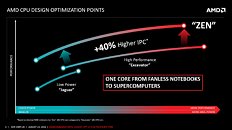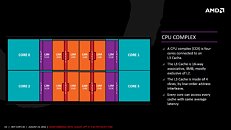Tuesday, August 23rd 2016

AMD Details ZEN Microarchitecture IPC Gains
AMD Tuesday hosted a ZEN microarchitecture deep-dive presentation in the backdrop of Hot Chips, outlining its road to a massive 40 percent gain in IPC (translated roughly as per-core performance gains), over the current "Excavator" microarchitecture. The company credits the gains to three major changes with ZEN: better core engine, better cache system, and lower power. With ZEN, AMD pulled back from its "Bulldozer" approach to cores, in which two cores share certain number-crunching components to form "modules," and back to a self-sufficient core design.
Beyond cores, the next-level subunit of the ZEN architecture is the CPU-Complex (CCX), in which four cores share an 8 MB L3 cache. This isn't different from current Intel architectures, the cores share nothing beyond L3 cache, making them truly independent. What makes ZEN a better core, besides its independence from other cores, and additional integer pipelines; subtle upscaling in key ancillaries such as micro-Op dispatch, instruction schedulers; retire, load, and store queues; and a larger quad-issue FPU.AMD also improved the cache system. The hierarchy is similar to pre-Bulldozer AMD architectures, with L3 cache being shared between full-fledged cores, and each core having a dedicated L2 cache. The L1 cache is now write-back (and not write-through), the SRAM that makes up the L2 and L3 caches are faster.The L3 cache SRAM has 5 times higher bandwidth than the L3 cache found on current AMD architectures. The L1 and L2 caches have 2 times the bandwidth. Load from cache to FPU is now faster. The core is endowed with 64 KB each of L1I cache, 32 KB L1D cache; 512 KB of dedicated L2 cache, and 8 MB of L3 cache shared between four cores in a CCX.ZEN introduces simultaneous multi-threading (SMT) to AMD processors. Intel's SMT implementation is the popular HyperThreading Technology. AMD's SMT is similar in that each core is addressed to as two threads, with each thread competing for the resources on the core.The third key area is lower-power, and this is attributed not just to the silicon-level gains yielded from the move to the 14 nm FinFET process. The design team focused on power-draw from the very inception of the ZEN core project. The L1 write-back cache, and the Op cache lower power-draw; the various components on ZEN processors feature aggressive clock-gating, although there's no power-gating.AMD expanded the ISA CPU instruction-sets, with AVX, AVX2, BMI1, BMI2, AES, RDRAND, sMEP, SHA1/SHA256, ADX, CFLUSHopt, XSAVEC/XSAVES/XRSTORS, and SMAP. The company also introduced a few AMD-exclusive instruction sets, which can be taken advantage of for better performance, including CLzero, and PTE Coalescing.
Beyond cores, the next-level subunit of the ZEN architecture is the CPU-Complex (CCX), in which four cores share an 8 MB L3 cache. This isn't different from current Intel architectures, the cores share nothing beyond L3 cache, making them truly independent. What makes ZEN a better core, besides its independence from other cores, and additional integer pipelines; subtle upscaling in key ancillaries such as micro-Op dispatch, instruction schedulers; retire, load, and store queues; and a larger quad-issue FPU.AMD also improved the cache system. The hierarchy is similar to pre-Bulldozer AMD architectures, with L3 cache being shared between full-fledged cores, and each core having a dedicated L2 cache. The L1 cache is now write-back (and not write-through), the SRAM that makes up the L2 and L3 caches are faster.The L3 cache SRAM has 5 times higher bandwidth than the L3 cache found on current AMD architectures. The L1 and L2 caches have 2 times the bandwidth. Load from cache to FPU is now faster. The core is endowed with 64 KB each of L1I cache, 32 KB L1D cache; 512 KB of dedicated L2 cache, and 8 MB of L3 cache shared between four cores in a CCX.ZEN introduces simultaneous multi-threading (SMT) to AMD processors. Intel's SMT implementation is the popular HyperThreading Technology. AMD's SMT is similar in that each core is addressed to as two threads, with each thread competing for the resources on the core.The third key area is lower-power, and this is attributed not just to the silicon-level gains yielded from the move to the 14 nm FinFET process. The design team focused on power-draw from the very inception of the ZEN core project. The L1 write-back cache, and the Op cache lower power-draw; the various components on ZEN processors feature aggressive clock-gating, although there's no power-gating.AMD expanded the ISA CPU instruction-sets, with AVX, AVX2, BMI1, BMI2, AES, RDRAND, sMEP, SHA1/SHA256, ADX, CFLUSHopt, XSAVEC/XSAVES/XRSTORS, and SMAP. The company also introduced a few AMD-exclusive instruction sets, which can be taken advantage of for better performance, including CLzero, and PTE Coalescing.













80 Comments on AMD Details ZEN Microarchitecture IPC Gains
If I had to guess... the flagship zen processor with 8c/16t and IPC within 5% of intel, you are looking ~$399. That's undercutting intel 6900K by a ton and will be a HUGE win for AMD and consumers in general. Again, no way they release at $260 if they are that comparable to Intel.
Consider this: 6700K costs what, $350 (MSRP)? Who (in their right mind) wouldn't pay for strikingly similar performance but with 8 'real' cores for $400? If you can't spend that cash, get the Hex or Octo priced less...
... but $260? No friggin way.
I can't believe my almost 7 year old Sandy Bridge is still fast, fluid and more or less current tech. Its performance and features should have been completely eclipsed by modern CPUs from both companies by now. A competitive AMD will help to finally make it obsolete, giving me a compelling reason to finally upgrade.
Also, when you are generous with the fast cache you are automagically increasing IPC and lowering power at the same time.
I wish they've said something about zen's IMC
tl;dr AMD has the reputation of being a poor man's intel/value chip, they need to change that image before things like price wars have any benefical gains in the long run. People who say that they vote with their wallets are full of crap or are limited to the enthusiast population which are a small %.
was it the 939 or am2 that had a lack of motherboards when it came out... thus alot of people went to intel.
It was an attempt to build something rather different, with x86 instruction set and idea that specialized hardware for z-buffering et all is not needed and it's better done in software.
It was basically a bunch of (simpler) x86 cores.
It would trounce usual GPUs at stuff like ray tracing and yadayada... but in the end Intel abandoned the idea as it didn't quite perform as expected.
Larrabee is not "in that domain" and there was no company on this planet with experience "in that domain" at all, Larrabee was that unique.
"They've put out a certain amount of technical disclosure in the past five weeks," he noted, "but although they make Larrabee sound like it's a fundamentally better approach, it sn't. They don't tell you the assumptions they made. They talk about scaling, but they disregard memory bandwidth. They make it sound good, but we say, you neglected half a dozen things."
"Every GPU we make, we always consider this type of design, we do a reasoned analysis, and we always conclude no. That's why we haven't built that type of machine."
"Intel is not a stupid company," he conceded. "They've put a lot of people behind this, so clearly they believe it's viable. But the products on our roadmap are competitive to this thing as they've painted it. And the reality is going to fall short of the optimistic way they've painted it."
"There's an incredible amount about Larrabee that's undefined," explained Keane, commenting on the specifications so far released. "You can't just say 'it's x86 so it's going to solve the massively parallel computing problem.'"
"Look at the PC," he continued. "With an OS they don't control, and applications coming from everywhere... to say arbitrarily that everything's going to scale to 32 cores seems to me to be a bit of a stretch. "
source: www.alphr.com/news/home-and-leisure/220947/larrabee-like-a-gpu-from-2006
A lot was uncertain, they tried and failed and I applaud Intel for trying.
But that was not the point. You were drawing "Intel can't do competitive high end GPU"'s from Larrabee fiasco. Which is a correct conclusion drawn from irrelevant fact.
Iris/HD GPUs show what they are capable of on GPU front (nothing impressive, although they keep improving)
If I can get a Zen processor that is 6c12t or 8c16t for around $350, I'm sold.
Yes intel is making great progress with their igpu, but they are still stuck in the entry level market. Seeing at what the gaming gpu market looks like, it's not like they don't have a chance with a good product. When everyone was stuck on the 28 nm, intel had a great 22nm and 14nm rolling out. Unless intel don't care anymore about the gaming segment, the only reason I can come up with, is that intel staff can't find idea that would be competitive with Amd/Nvidia. If intel could actually make something competitive even with a RX 470 or a GTX 1060, I would be happy. More competition is always good.
"The Plus Side of AMD:
Some benefits that AMD processors come with are that they run cooler in your system and are then more quiet and use up less power."
:D:po_O
hubpages.com/technology/best-amd-processor
... seems finally zen's gonna change things for amd